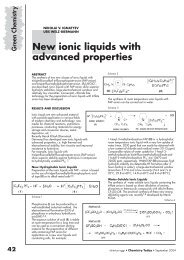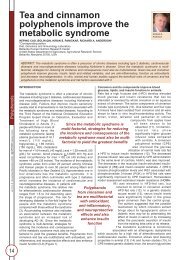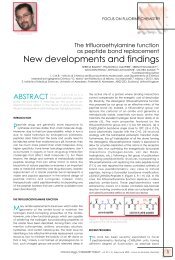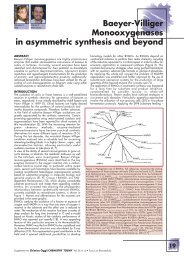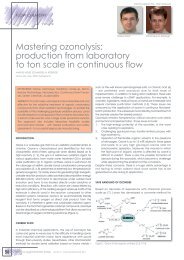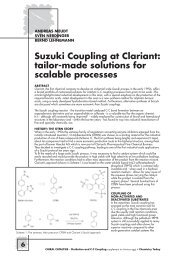Safety of saccharin
Safety of saccharin
Safety of saccharin
Create successful ePaper yourself
Turn your PDF publications into a flip-book with our unique Google optimized e-Paper software.
Sweeteners<br />
vol 19 n 6 - November/December 2008 - AgroFOOD industry hi-tech<br />
24<br />
<strong>Safety</strong> <strong>of</strong> <strong>saccharin</strong><br />
SAMUEL M. COHEN 1,2 *, LORA L. ARNOLD 1 , JAMES L. EMERSON 3<br />
*Corresponding author<br />
1.Department <strong>of</strong> Pathology and Microbiology<br />
University <strong>of</strong> Nebraska Medical Center<br />
983135 Nebraska Medical Center<br />
Omaha, NE, 69198-3135, USA<br />
2.Havlik-Wall Pr<strong>of</strong>essor <strong>of</strong> Oncology<br />
3. 290 Landfall Rd., N.W.<br />
Atlanta, GA, 30328, USA<br />
INTRODUCTION<br />
Saccharin has been the focus <strong>of</strong> controversy nearly since<br />
its initial synthesis in 1879 by Fahlberg and Remsen. Its<br />
primary use has been as a non-caloric synthetic sweetener,<br />
but it is also being used commercially for a variety <strong>of</strong> other<br />
purposes including as an antiseptic, preservative, nickelplating,<br />
antistatic agent, and numerous other uses. It is an<br />
inexpensive, extremely stable chemical that is resistant to<br />
heat. Numerous toxicological effects have been attributed<br />
to <strong>saccharin</strong>, dating to its initial proposed use as a<br />
sweetener. There is the famous quote by President<br />
Theodore Roosevelt in response to being told that<br />
<strong>saccharin</strong> was “injurious to health” by Dr. Harvey W. Wiley<br />
<strong>of</strong> the US Department <strong>of</strong> Agriculture: “You tell me that<br />
<strong>saccharin</strong> is injurious to health? Why my doctor gives it to<br />
me everyday. Anybody who says <strong>saccharin</strong> is injurious to<br />
health is an idiot”. Most <strong>of</strong> the various accusations<br />
regarding the toxicity <strong>of</strong> <strong>saccharin</strong> were addressed over the<br />
years, with its commercial use continuing. In 1970 a new<br />
controversy swirled around the use <strong>of</strong> <strong>saccharin</strong> as an<br />
artificial sweetener with the discovery that it produced<br />
bladder cancer when administered to rats in a twogeneration<br />
bioassay. Significant concern ensued that it<br />
might also pose a cancer risk to humans. Addressing this<br />
controversy has extended the limits <strong>of</strong> toxicological testing<br />
and mechanistic considerations, with results not only<br />
influencing the decision regarding <strong>saccharin</strong> but also setting<br />
precedence for numerous other chemicals in various<br />
settings, not just food additives. For a history <strong>of</strong> <strong>saccharin</strong>,<br />
including the more recent controversy involving bladder<br />
cancer, the readers are encouraged to read several reviews<br />
on the subject (1-4).<br />
Animal testing is the foundation for toxicological screening<br />
<strong>of</strong> chemicals for nearly all uses, including food additives.<br />
There are two basic assumptions when using animal<br />
models for such screening (2, 5): 1) the toxic effect<br />
produced in the test species will also occur in humans<br />
(species extrapolation); and 2) the effect seen at the doses<br />
used in the screening evaluation are relevant to the levels<br />
to which humans are exposed (dose extrapolation). For<br />
many chemicals and toxic endpoints, these assumptions<br />
are reasonable. However, it is only with mechanistic<br />
understanding that one can address either <strong>of</strong> these<br />
assumptions. For the influence <strong>of</strong> <strong>saccharin</strong> on the bladder<br />
in rats, based on extensive mechanistic research, neither<br />
<strong>of</strong> these assumptions were found to be valid. It is a rat<br />
specific phenomenon and it only occurs at extremely high<br />
doses (25,000 ppm <strong>of</strong> the diet and higher).<br />
SACCHARIN CARCINOGENICITY STUDIES<br />
Samuel M.<br />
Cohen<br />
ABSTRACT: Long term treatment with high doses <strong>of</strong> sodium <strong>saccharin</strong> in the diet beginning in utero or at birth induces urinary bladder<br />
tumours in the rat with a higher incidence in male rats compared to female rats. After one <strong>of</strong> the most extensive toxicological<br />
evaluations <strong>of</strong> any chemical, it ultimately was shown that <strong>saccharin</strong>-induced bladder cancer in rats is a species-specific high<br />
dose phenomenon, and it is now accepted that <strong>saccharin</strong> does not pose a cancer risk to humans. The methodology utilized and<br />
the issues investigated in the research with <strong>saccharin</strong> have greatly extended the sciences <strong>of</strong> toxicology, epidemiology and risk<br />
assessment for chemicals.<br />
Saccharin is one <strong>of</strong> most intensely investigated chemicals<br />
regarding its possible carcinogenicity, including multiple<br />
rodent bioassays, extensive epidemiology investigations,<br />
and mechanistic evaluations (2-5). For the most part,<br />
standard one-generation bioassays in rodents have been<br />
negative if administration begins at the usual age <strong>of</strong> 4-8<br />
weeks. Based on a suggestion by Dr. Leo Friedman at the<br />
US Food and Drug Administration (FDA), <strong>saccharin</strong> was<br />
one <strong>of</strong> the first chemicals to be evaluated in a twogeneration<br />
bioassay (1). This involves administration <strong>of</strong> the<br />
test chemical to the dams prior to conception, continuing<br />
during gestation and lactation, and then continuing<br />
administration to the <strong>of</strong>fspring (F 1 ) generation for a period<br />
<strong>of</strong> two years after weaning. In two-generation bioassays,<br />
<strong>saccharin</strong> produced an increased incidence <strong>of</strong> bladder<br />
tumours in rats, particularly in male rats. The results<br />
generally have not been statistically significant in female<br />
rats, but tumours and preneoplastic proliferative lesions<br />
have occurred in females. The initial two-generation<br />
bioassay was performed by the Wisconsin Alumni Research<br />
Foundation (WARF), and was repeated by the FDA. There<br />
were concerns in these two studies regarding procedural<br />
aspects as well as the purity <strong>of</strong> the <strong>saccharin</strong>, including<br />
contamination with o-toluenesulfonamide (OTS). This led to<br />
a study performed in Canada which was designed to<br />
address these problems and was to be utilized as the<br />
“ultimate” test for a regulatory decision regarding the<br />
carcinogenicity <strong>of</strong> <strong>saccharin</strong>. Based on the Canadian study,<br />
it was concluded that the bladder cancer effects in rats in a<br />
two-generation bioassay were due to the <strong>saccharin</strong> and<br />
were not due to OTS or procedural inadequacies in the<br />
testing. Based on these results, Canada banned the use <strong>of</strong><br />
<strong>saccharin</strong> for dietary uses, and the US FDA proposed a<br />
similar ban. Because <strong>of</strong> an outcry from the public, since the<br />
only other artificial sweetener, cyclamate, had already been<br />
banned in the United States, Congress passed a<br />
moratorium delaying the ban by the FDA until additional<br />
research could be completed. A fourth two-generation<br />
bioassay was performed at the International Research and<br />
Development Corporation (IRDC) laboratory involving a<br />
large number <strong>of</strong> animals so that a detailed dose response<br />
could be determined (6). In addition, the effects <strong>of</strong><br />
administration in utero compared to post-gestational<br />
exposure was evaluated. The study examined only the<br />
male <strong>of</strong>fspring. They were able to show that there was no<br />
significant effect at a dose below 3 percent <strong>of</strong> the diet.<br />
Furthermore, they were able to show that beginning
administration at the time <strong>of</strong> birth<br />
produced the same results as exposure<br />
beginning prior to conception, through<br />
gestation and onward. This clearly<br />
indicated that the effect was a high dose<br />
phenomenon, and also indicated that<br />
the effect was due to exposure after<br />
birth, not due to in utero exposures.<br />
While the two-generation studies were<br />
being performed in the 1970’s there<br />
were also several investigations<br />
examining <strong>saccharin</strong> as a so called<br />
“tumour promoter” (2, 4). This involved<br />
administering <strong>saccharin</strong> in the diet after<br />
the rats had been pre-treated with a<br />
known, potent, DNA reactive bladder<br />
carcinogen. Under these circumstances,<br />
high doses <strong>of</strong> <strong>saccharin</strong> (usually 5<br />
percent or more <strong>of</strong> the diet, but positive<br />
results were obtained with doses <strong>of</strong> 2.5<br />
percent <strong>of</strong> the diet or higher) yielded a<br />
high incidence <strong>of</strong> bladder tumours. Long<br />
term (usually 2 years) studies were positive when the rats<br />
had been pretreated with one <strong>of</strong> a variety <strong>of</strong> potent, known<br />
bladder carcinogens, such as N-methyl-N-nitrosourea<br />
(MNU), N-[4-(5-nitro-2-furyl)-2-thiazolyl]formamide<br />
(FANFT), or N-butyl-N-(4-hydroxybutyl)nitrosamine (BBN),<br />
but not 2-acetylamin<strong>of</strong>luorene (2-AAF). These studies<br />
involved administration to animals beginning at 4-8 weeks<br />
<strong>of</strong> age or older. In the groups administered only sodium<br />
<strong>saccharin</strong>, bladder tumours were either not detected or<br />
were not present at statistically significant incidences.<br />
These studies were designed to follow the initiationpromotion<br />
protocols originally developed in mouse skin and<br />
later in rat liver.<br />
Thus, by the end <strong>of</strong> the 1970’s, there was considerable<br />
evidence that <strong>saccharin</strong> administered in the diet (but not in<br />
the drinking water) increased the incidence <strong>of</strong> bladder<br />
cancer in rats, particularly in males. By this time there was<br />
considerable effort to investigate the mechanism that was<br />
involved in producing these rat bladder tumours so that the<br />
possible risk to humans could be rationally assessed.<br />
MECHANISTIC STUDIES OF SACCHARIN-INDUCED<br />
CARCINOGENICITY IN THE RAT<br />
Mechanistically, a chemical can increase the risk <strong>of</strong> cancer<br />
either by direct DNA damage (DNA reactivity) or by<br />
increasing cell proliferation (5). Increasing cell proliferation<br />
can either be by increasing cell births or decreasing cell<br />
deaths with a corresponding accumulation <strong>of</strong> cells.<br />
Extensive investigations have been performed addressing<br />
these possibilities. In all <strong>of</strong> the bioassays in rats, the form<br />
<strong>of</strong> <strong>saccharin</strong> that was administered was the sodium salt.<br />
Saccharin is a moderately strong acid with a pK a <strong>of</strong> 1.8 (2,<br />
4). The acid itself is quite insoluble in aqueous media.<br />
Commercially, one <strong>of</strong> the salts is used for dietary use,<br />
usually sodium, but calcium <strong>saccharin</strong> has also been used.<br />
The <strong>saccharin</strong> anion is not metabolized by mammalian<br />
organisms (1, 2). Thus, whatever is ingested is excreted<br />
intact. Most is excreted in the urine in rodents as well as in<br />
humans. The genotoxicity <strong>of</strong> <strong>saccharin</strong> has been examined<br />
extensively in a variety <strong>of</strong> in vitro and in vivo assays (1, 2,<br />
4). It has generally produced negative results in the in vitro<br />
studies and has been uniformly negative in the in vivo<br />
assays. In vitro it has produced positive results in a few<br />
assays, but confounding factors were ultimately identified<br />
which caused the apparent positive response. These<br />
effects included primarily the high ionic strength and<br />
osmolality that is required with the salts and to a lesser<br />
extent the influence on pH <strong>of</strong> the medium. Following the<br />
discovery <strong>of</strong> these effects by <strong>saccharin</strong> salts, it has become<br />
standard practice to evaluate these two parameters in any<br />
in vitro genotoxicity evaluation to avoid a false positive<br />
interpretation <strong>of</strong> the test (7). Based on the results <strong>of</strong> these<br />
genotoxicity assays, <strong>saccharin</strong> is considered not to be<br />
genotoxic, and more specifically, it is not considered DNA<br />
reactive. DNA reactivity is highly unlikely given the anionic<br />
nature <strong>of</strong> the <strong>saccharin</strong> ion, lack <strong>of</strong> metabolic conversion,<br />
and lack <strong>of</strong> any reactive site that is available for its<br />
interaction with DNA. Furthermore, an in vivo-in vitro assay<br />
evaluating the unscheduled DNA synthesis following<br />
<strong>saccharin</strong> administration was negative as was examination<br />
for interaction <strong>of</strong> <strong>saccharin</strong> covalently with the DNA <strong>of</strong> the<br />
urothelium <strong>of</strong> the bladder, the target tissue (2, 4).<br />
Thus, the mode <strong>of</strong> action <strong>of</strong> <strong>saccharin</strong> effects on the urinary<br />
bladder epithelium <strong>of</strong> the rat must involve an increase in<br />
cell proliferation. Such an increase was demonstrated<br />
utilizing tritiated-thymidine or bromodeoxyuridine (BrdU)<br />
incorporation as methods for assessing DNA replication (2).<br />
The labelling index is increased following dietary<br />
administration <strong>of</strong> sodium <strong>saccharin</strong> by 2-10 times compared<br />
to the control bladder urothelium, which is a slowly<br />
proliferating tissue (turnover <strong>of</strong> approximately 100-200<br />
days). The increased proliferation was shown to be due to<br />
a regenerative response to cytotoxicity involving the<br />
superficial cell layer <strong>of</strong> the urothelium. Since the superficial<br />
cells <strong>of</strong> the urothelium can be extremely thin, it can be<br />
difficult to demonstrate cytotoxicity using routine light<br />
microscopic examination. By examining the entire luminal<br />
surface <strong>of</strong> the urinary bladder by scanning electron<br />
microscopy (SEM), the multifocal, superficial nature <strong>of</strong> the<br />
cytotoxicity, necrosis, and exfoliation could be demonstrated<br />
along with the early proliferative changes. Thus, the<br />
determining factor for <strong>saccharin</strong>-induced, rat bladder<br />
carcinogenesis was the process by which cytotoxicity was<br />
induced.<br />
The initial clue that led to the ultimate demonstration <strong>of</strong> the<br />
mechanism producing urothelial cytotoxicity was an<br />
observation that the effects on the urinary bladder and on<br />
the urine composition following the administration <strong>of</strong><br />
different salts or acid form <strong>of</strong> <strong>saccharin</strong> were considerably<br />
different (2). Thus, the urothelial toxicity and proliferative<br />
response to sodium <strong>saccharin</strong> was the greatest, followed<br />
by potassium <strong>saccharin</strong>. A small but statistically insignificant<br />
change occurred in response to calcium <strong>saccharin</strong>, and no<br />
effect was seen with acid <strong>saccharin</strong>. The amount <strong>of</strong><br />
<strong>saccharin</strong> in the diet was the same for each <strong>of</strong> these, and<br />
the amount <strong>of</strong> <strong>saccharin</strong> excreted in the urine was also the<br />
Sweeteners<br />
AgroFOOD industry hi-tech - November/December 2008 - vol 19 n 6 25
Sweeteners<br />
vol 19 n 6 - November/December 2008 - AgroFOOD industry hi-tech<br />
26<br />
same regardless <strong>of</strong><br />
the form <strong>of</strong> <strong>saccharin</strong><br />
that was administered.<br />
However, there were<br />
dramatic differences<br />
in concentrations <strong>of</strong><br />
the normal urinary<br />
constituents,<br />
especially the pH.<br />
F o l l o w i n g<br />
administration <strong>of</strong> acid<br />
<strong>saccharin</strong>, the urinary<br />
pH is 6.5, usually<br />
7.0 or above. Calcium<br />
<strong>saccharin</strong> produced<br />
urinary pH that varied<br />
slightly above or below<br />
6.5. Based on the<br />
significant changes in<br />
urinary composition<br />
following sodium<br />
s a c c h a r i n<br />
administration at high doses, a calcium phosphatecontaining<br />
precipitate forms in the urine (2-5, 8-10). This<br />
precipitate also contains silicate, mucopolysaccharide,<br />
protein, and low quantities <strong>of</strong> the <strong>saccharin</strong> anion (
Sweeteners<br />
vol 19 n 6 - November/December 2008 - AgroFOOD industry hi-tech<br />
28<br />
much higher concentrations <strong>of</strong><br />
protein due to the presence <strong>of</strong> α 2u -<br />
globulin compared to the female.<br />
The NBR strain <strong>of</strong> rats does not<br />
produce the same high levels <strong>of</strong><br />
α 2u -globulin in the males as in other<br />
strains <strong>of</strong> rats. In the NBR strain <strong>of</strong><br />
rats, sodium <strong>saccharin</strong> produces<br />
the same slight effect in the male<br />
as in the female, considerably less<br />
<strong>of</strong> a response than seen in male<br />
rats <strong>of</strong> other strains with α 2u –<br />
globulin in large quantities. If it is<br />
the high exposures <strong>of</strong> primarily the<br />
sodium (and to a lesser extent the<br />
potassium) salt <strong>of</strong> <strong>saccharin</strong> that<br />
produces these effects, can sodium<br />
and potassium salts <strong>of</strong> other moderately strong acids also<br />
produce a similar effect? The answer is an emphatic yes<br />
(8-10, 14). A large number <strong>of</strong> sodium salts have been<br />
tested for formation <strong>of</strong> calcium phosphate-containing<br />
precipitate, urothelial cytotoxicity and increased<br />
proliferation as well as tumour promoting activity. One <strong>of</strong><br />
these sodium salts, sodium ascorbate (vitamin C), has<br />
also been evaluated in a two-generation bioassay. The<br />
exception is sodium hippurate, which does not produce a<br />
proliferative or tumour promoting effect in the rat bladder<br />
(10, 14). As frequently occurs in biology, it is exceptions<br />
like this that help define specific mechanisms. For<br />
reasons that are unclear, doses <strong>of</strong> sodium hippurate<br />
comparable to the carcinogenic dose <strong>of</strong> sodium<br />
<strong>saccharin</strong>, in contrast to the other sodium salts, produces<br />
a urinary pH in the rat <strong>of</strong>



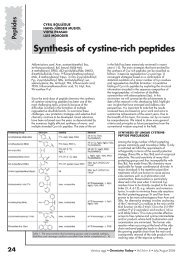
![Pietro Delogu [modalità compatibilità]](https://img.yumpu.com/12255149/1/190x135/pietro-delogu-modalita-compatibilita.jpg?quality=85)
